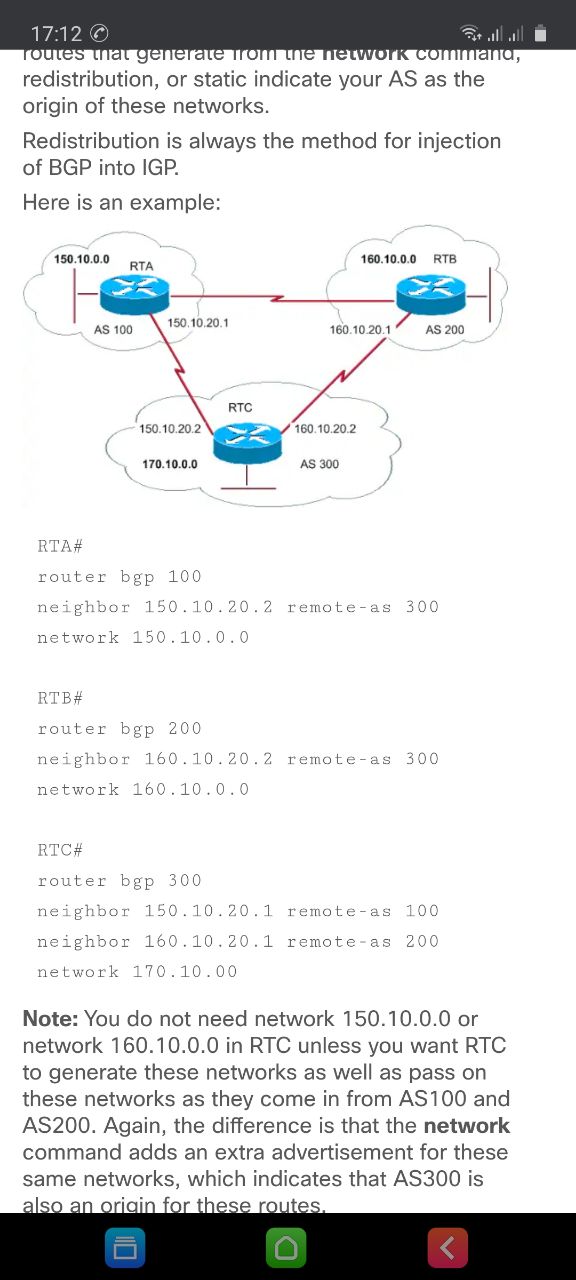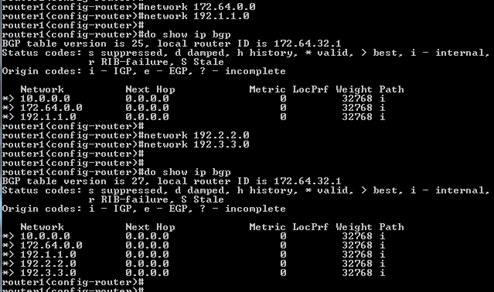KR
Size: a a a
2020 August 15
Auto-summary выключен
KR

For example, network 192.213.0.0 was once an illegal class C network. Now, the network is a legal supernet, 192.213.0.0/16. The "16" represents the number of bits in the subnet mask, when you count from the far left of the IP address. This representation is similar to 192.213.0.0 255.255.0.0.
J
То, что нужно! Спасибо.
В вводных выше на самом деле сети принадлежали class C и рухтер делал предположение о размере маски по следующей логике.
Let’s use the network command without the mask to advertise these prefixes to router2. Thinking about specifying a network without a mask, we have to assume that the router is making an assumption about the network. That is, the router must be using some sort of predetermined specification to determine what network it will advertise as well as what subnet mask that prefix will have.
Class A – Has a /8 subnet mask. First octet between 1 and 126.
Class B – Has a /16 subnet mask. First octet between 128 and 191.
Class C – Has a /24 subnet mask. First octet between 192 and 223.
В вводных выше на самом деле сети принадлежали class C и рухтер делал предположение о размере маски по следующей логике.
Let’s use the network command without the mask to advertise these prefixes to router2. Thinking about specifying a network without a mask, we have to assume that the router is making an assumption about the network. That is, the router must be using some sort of predetermined specification to determine what network it will advertise as well as what subnet mask that prefix will have.
Class A – Has a /8 subnet mask. First octet between 1 and 126.
Class B – Has a /16 subnet mask. First octet between 128 and 191.
Class C – Has a /24 subnet mask. First octet between 192 and 223.
J
Ещё нагляднее ниже. Обе сети были добавлены с “..mask 255.255.255.0”.
router bgp 777
address-family ipv4
network 191.0.0.0 mask 255.255.255.0
network 192.0.0.0KR
То, что нужно! Спасибо.
В вводных выше на самом деле сети принадлежали class C и рухтер делал предположение о размере маски по следующей логике.
Let’s use the network command without the mask to advertise these prefixes to router2. Thinking about specifying a network without a mask, we have to assume that the router is making an assumption about the network. That is, the router must be using some sort of predetermined specification to determine what network it will advertise as well as what subnet mask that prefix will have.
Class A – Has a /8 subnet mask. First octet between 1 and 126.
Class B – Has a /16 subnet mask. First octet between 128 and 191.
Class C – Has a /24 subnet mask. First octet between 192 and 223.
В вводных выше на самом деле сети принадлежали class C и рухтер делал предположение о размере маски по следующей логике.
Let’s use the network command without the mask to advertise these prefixes to router2. Thinking about specifying a network without a mask, we have to assume that the router is making an assumption about the network. That is, the router must be using some sort of predetermined specification to determine what network it will advertise as well as what subnet mask that prefix will have.
Class A – Has a /8 subnet mask. First octet between 1 and 126.
Class B – Has a /16 subnet mask. First octet between 128 and 191.
Class C – Has a /24 subnet mask. First octet between 192 and 223.
☺️☺️☺️
I
я уже говорил, что цискологику придумали больные ублюдки?
KR
я уже говорил, что цискологику придумали больные ублюдки?
Было дело 😅
Они кажется сейчас перешли в отдел firepower ))))
Они кажется сейчас перешли в отдел firepower ))))
N
А чо есть люди кто сетку без маски в бгп пишет?
J
А чо есть люди кто сетку без маски в бгп пишет?
Оно само без маски в конфиг сетку пишет, оло
J
Больные ублюдки
A
Iddqd
expect в 2020-м? не ожидал (каламбур получился) 😂
ну что было под рукой
N
Iddqd
expect в 2020-м? не ожидал (каламбур получился) 😂
А как модно сейчас
I
Скрапить кли модно нетмикой или скрапли (я там привел пример). Но еще модней нетконф/рестконф
PL
Iddqd
Скрапить кли модно нетмикой или скрапли (я там привел пример). Но еще модней нетконф/рестконф
Скрапить было модно когда про api не слышали..
I

J
@AntoninBarklyite: user has been CAS banned
NK
Ещё один проект "Давайте построим хз что, просто потому что мы можем".
Люблю такие штуки нерациональной любовью.
https://ikarus.sg/how-i-built-kraken/
Люблю такие штуки нерациональной любовью.
https://ikarus.sg/how-i-built-kraken/
C
ID:0
Ещё один проект "Давайте построим хз что, просто потому что мы можем".
Люблю такие штуки нерациональной любовью.
https://ikarus.sg/how-i-built-kraken/
Люблю такие штуки нерациональной любовью.
https://ikarus.sg/how-i-built-kraken/
👍круто
KK
👍круто
Очень ДА! )))






